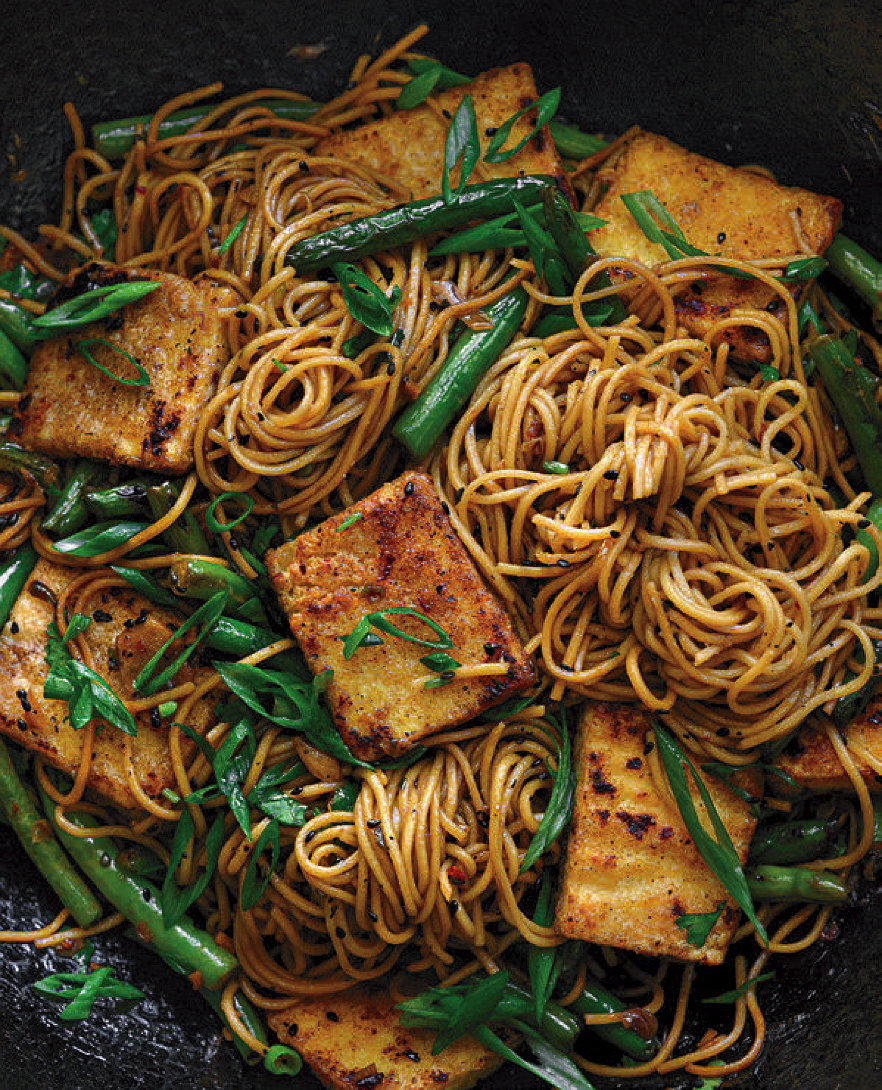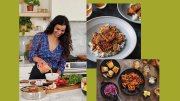For her first vegan cookbook, published in 2019, Nisha Vora, J.D. ’12, had five and a half months to develop, test, and photograph all the recipes. After she cultivated a following on the vegan cooking blog Rainbow Plant Life, Penguin, Random House contacted Vora, asking her to create a book of vegan Instant Pot recipes—fast. “I was like, ‘Me? Do you have the right email?’” says Vora, who left a legal career in 2016 to focus on vegan food writing and recipe development.
While proud of her first book, Vora says, “It’s not necessarily … a Nisha book.” By comparison, her new cookbook, Big Vegan Flavor, which comes out in September, took two and a half years to finalize. “I wanted the opportunity to be as meticulous as I could be. I wanted to be able to deliver only recipes where I’m like, ‘This is a 10 out of 10.’”
Vora perfected the recipes at home in San Diego, hiring a recipe tester to help with prep, cleanup, and fine-tuning. “If we looked at each other like, ‘Wow,’” Vora says, then “we cracked the code.” She takes seriously the challenge of making vegan recipes good, not just “good for vegan,” so she investigated methods of flavoring old standby plant-based ingredients. With her sticky coconut milk-braised tofu, for example, Vora wanted to offer a dish as delicious as fried crispy tofu but with a twist. “I had a Chinese takeout dish that was some sort of braised tofu, and I was like, ‘This is fantastic. It’s chewy, and it’s meaty, and it’s savory, and I somehow like it possibly more than crispy tofu.’” She researched the Chinese technique for frying and braising tofu so the full-bodied coconut, ginger, garlic, lemongrass, and soy sauce seep in, creating a deeply flavorful protein.

Many of Vora’s recipes are based on sentimental favorites, like a buttermilk fried mushroom she says is popular with chicken-loving non-vegans and a spicy noodle stir-fry with salt and pepper tofu inspired by the flavors from a Chinese restaurant. She does not claim to provide culturally authentic recipes, but she researches regional techniques and ingredients. “When I develop a recipe from a different culture, I like to know the roles that certain ingredients play, and I like to know what the common cooking techniques are so that I can deliver a respectful interpretation that’s not totally watered down.”
Accordingly, she describes a crispy lentil dish of hers as “Indian-ish.” Vora’s first true cooking teachers were Food Network personalities like the Barefoot Contessa and Alton Brown, and she began cooking for herself at 14. Her parents had emigrated to New Jersey from Mumbai in 1982 so her father could build his medical career. After hearing that doctors were needed in the small desert town of Barstow, California, her parents moved there with Nisha and her sister sight unseen, with little money, and started what is now a 25-year-old family practice. As she grew up, no longer a small-town teenager anxious to assimilate, Nisha wanted to connect more meaningfully with her Indian ancestry by watching her mother cook. The only problem was, her mother didn’t use measuring cups or spoons, relying instead on intuition. “[That] is antithetical to how I cook and how I have to cook to develop precise recipes,” Vora says. “But watching her, asking her questions, her knowledge over the last 40 years of cooking as a home cook has helped inform how I understand ingredients and how they fit together.” Most of her Indian recipes, for example, start with toasting a combination of whole spices in oil, then adding aromatics like onions until they’re softened and golden, followed by garlic, green chiles, and ginger, and, finally, some combination of ground spices, a layering technique Vora learned from her mother.
Big Vegan Flavor offers information on food prep, ingredients, and recommendations for making the most of the book’s 150 recipes. “I wanted to provide a comprehensive approach to mastering vegan cooking, to equip readers with the tools and the techniques and the tricks and tips that I use to whip up dinner on a Wednesday night, even if you’re not following the specific recipe,” Vora says. She says that the key to spreading the word of vegan options is showing, not telling. “I’m going to show you how delicious plant-based food can be without being like, ‘You’re a bad person if you’re not vegan.’ Nobody wants to hear that. My goal is to get people to eat more plant-based food even if they don’t ultimately become vegans.”
Vora attended college at the University of California, Berkeley, majoring in political science and legal studies, before proceeding to Harvard Law in 2009. She never lost her love for food, though, and remembers bonding with law school classmates at monthly potluck meetups. “Every time I made something, and I’m not saying this to brag, everyone was like, ‘Wow, how did you make this?’ I remember just feeling so happy when I would share food with others.” In 2016, she became a practicing vegan, inspired by documentaries about factory farming.
After law school, she moved to New York City, but her jobs at a big law firm and a smaller nonprofit in which she represented low-income tenants in housing court, left her professionally unhappy, and after a few years, she left the field. But she says some lessons from Harvard Law still apply to her work today, especially writing and analytic skills, but also her rigorous and meticulous approach to food. “When I was developing a chocolate chip recipe, I did a mountain of research on ingredient ratios in non-vegan chocolate chip cookies, the percentage of butter, the percentage of fat, the percentage of eggs, so that I could come up with a recipe that tastes just as delicious and is just as chewy and has crispy edges like a regular chocolate chip cookie. I bring this super analytical lens that I think comes from having that background as a law student and as a lawyer.”









